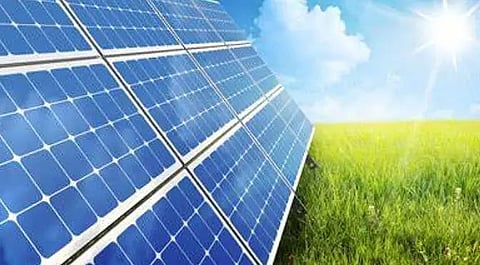
- Home
- Live Blog
- Breaking News
- Top Headlines
- Cities
- NE News
- Sentinel Media
- Sports
- Education
- Jobs

There is no shortage of money for the installation of solar power projects in the Northeast region, but the underutilization of available funds points towards challenges that need to be overcome. For the region, harnessing the potential of solar and other renewable energy is critical to protecting its fragile ecology and meeting the decarbonization goals in the energy sector. A report of the Parliamentary Standing Committee on New and Renewable Energy has shed light on the challenges faced in the implementation of solar energy projects in the region. The report highlights key reasons cited by the Ministry of New and Renewable Energy for the underutilization of allocated funds. Firstly, due to low solar insolation (the amount of solar radiation received in an area), the output of such projects is less, and the cost is relatively high due to their remoteness. This results in a higher tariff and makes it unviable for electricity distribution companies (DISCOMs) to purchase it, the ministry states and adds: “Even schemes with subsidies and VGF (viability gap funding) specially designed for these regions find few takers as it is cheaper for utilities to purchase cheaper power from other states than to produce in their own state.” Secondly, solar power projects are land intensive, requiring large flat tracts of shadow-free, contiguous land with accessibility, which the ministry claims is difficult to find in the region. The third reason for the non-receipt of an adequate number of proposals from state governments for setting up grid-connected solar projects is a bit ambiguous. If the first two reasons are accepted to be valid, then even if the North-Eastern States submit more proposals, the viability of the projects will still be less unless the amount of subsidy or VGF is increased to make those viable for DISCOMs. The National Institute of Solar Energy has estimated the country’s total solar energy potential at 62.3 GW in the region, including 13.76 GW in Assam. Weighing the reasons cited by the Ministry against such an estimation of solar energy potential is necessary to draw a pragmatic roadmap for harnessing solar and other renewable energy in the region. Physical achievements under the PM-KUSUM (Prime Minister’s Kisan Urja Suraksha Evam Utthan Mahaabhiyan) scheme of installation of off-grid solar pumps for irrigation in the region present a mismatch between targets and installation. Of the total 14,771 sanctioned standalone solar-powered pumps under component B of the PM-KUSUM scheme, only 1237 pumps have been installed in the region, while against 27 sanctioned ground-mounted grid-connected solar plants under component A of the scheme and 13600 sanctioned grid-connected solar-powered agriculture pumps, no installation has been made in any of the states, the parliamentary report reveals. The majority of farmers in the region are dependent on rain-fed farming due to poor irrigation coverage, which makes the installation of solar-powered pumps a prime necessity to boost production and productivity. The Ministry has observed that the difficulties faced by farmers in accessing affordable financing were a major hurdle in the implementation of the allotted projects across the country. Implementation of the solar rooftops programme, which involves generating solar electricity by installing solar panels on the roofs of houses, can play a crucial role in reducing demand for fossil-fuel-based electricity and achieving the goals of decarbonizing energy generation in the country. The Central government developed a national portal to facilitate any resident from anywhere in the country to apply for rooftop solar without waiting for the DISCOMs concerned to finalise the tender. Under the modified rules, the role of DISCOMs in the programme has been limited to issuing technical feasibility approval, installation of the net metre, and inspection of the system, while the consumer has the choice to select any vendor registered with DISCOMs and choose quality and efficiency of solar equipment. After installation of the net meter and inspection of the system by the DISCOM concerned, subsidy is released directly into the bank account of the consumer. Information furnished by the Ministry to the parliamentary panel reveals that of the total 38,413 applications totaling 211 megawatts of solar electricity submitted through the national portal, 14,961 applications (65 MW) have been approved by the DISCOMs, while only 1674 solar rooftops have been installed till February 2023. The data is indicative of the slow pace of implementation of the solar energy schemes, programmes, and projects when the country has set an ambitious target of generating 230 GW of solar energy by 2030. The installed capacity in the entire country till December 2022 is 63 GW, against the target for the installation of 175 GW of renewable energy, including 100 GW from solar, 60 GW from wind, 10 GW from bio-power, and 5 GW from small hydropower. The central government, state governments, and DISCOMs holding joint consultations over the challenges faced in the implementation of the solar energy schemes can help find realistic solutions. As challenges faced by DISCOMs, consumers, and farmers vary, more emphasis needs to be placed on finding state-specific solutions.